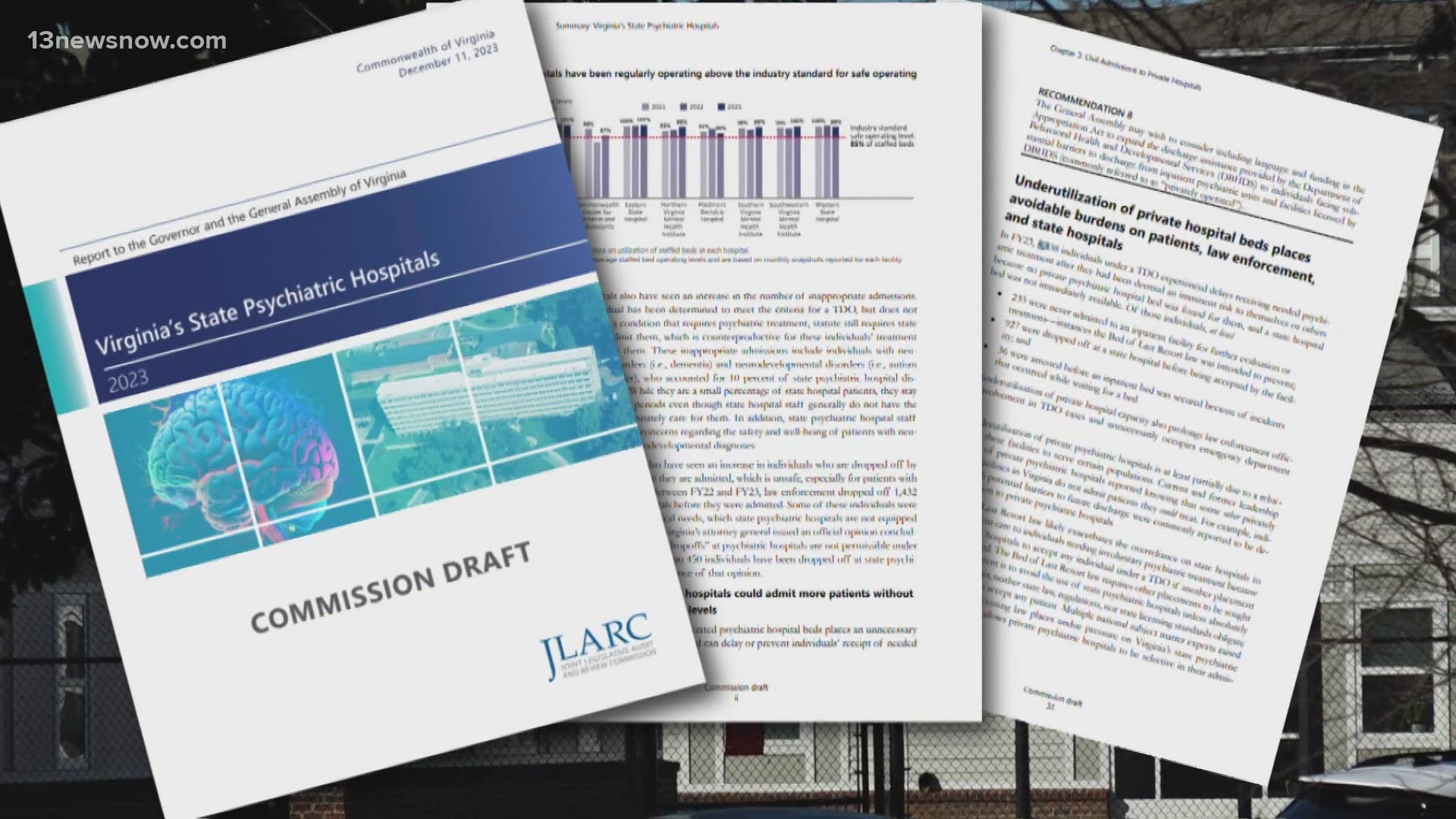NORFOLK, Va. — A new report published by the Joint Legislative Audit and Review Committee found that Virginia’s psychiatric hospital system, including both patients and staff, is "at risk" as it faces concerns of understaffing and high admission numbers.
The new JLARC report revealed that the growing demand for in-patient beds and plateauing supply is increasingly putting a strain on the state’s nine psychiatric hospitals.
Many of the concerns brought forth stem from current Virginia state law that does not allow a state hospital to deny admission to an individual under a civil "Temporary Detention Order."
The report details the dilemmas from capacity, increasing number of admissions, pay and staffing concerns.
'Unsafe' operating levels
According to the JLARC report, an industry standard of 85% occupancy rate being the threshold for operating at a "safe operating level" exists so psychiatric hospital staff can adjust to case appropriately.
The average occupancy rate across Virginia's nine hospitals is 97%, with some hospitals including Eastern State Hospital in Williamsburg operating at full capacity.
The high capacity numbers have led to both civil and forensic (criminal justice system) waitlists. In Fiscal Year 2023, more than 8,500 people under a civil "Temporary Detention Order."
"Some of those ended up at a state hospital eventually, others went to a private psychiatric hospital. There are some we know of that never ended up getting the treatment they needed, around 200-plus individuals," Drew Dickinson said, Chief Legislative Analyst for JLARC who is one of the authors of the report.
He added that those patients waited, on average, more than 40 hours before they were admitted to some kind of medical care.
More than 500 criminal defendants in 2023 were also delayed admission to a state hospital.
Law enforcement 'drop-offs'
Between 2022 and 2023, more than 1,432 people were dropped off at a state hospital by law enforcement before a hospital formally accepted them for admission.
“We know law enforcement officers are under a lot of pressure, they have to wait with a TDO until that patient gets treatment. But we’re finding some agencies are dropping them off at state hospitals before they’re medically cleared to come in," Dickinson said.
Other findings
- Individuals who do not need psychiatric treatment are being placed under TDOs and admitted to state psychiatric hospitals, risking their safety and complicating hospital operations.
- Many private psychiatric hospitals could admit more involuntary patients without exceeding safe operating levels.
- An increase in competency restoration patients at state hospitals has reduced the capacity for civil admissions and contributed to unsafe operating levels.
- State hospitals struggle to recruit and retain staff, especially for certain clinical and nursing positions, and retention and recruitment challenges have increased over the past decade.
- Concerns related to pay, scheduling, personal safety, and support are driving state hospital staffing difficulties.
"Staffing challenges over the last decade have gotten worse, both turnover rates and vacancy rates with the vacancy leading to hiring out temporary positions and overtime," Dickinson said.
Recommendations
- The General Assembly may wish to consider allowing state hospitals to delay admission of an individual under a temporary detention order until the state hospital has determined the individual does not have urgent medical needs that the state hospital cannot treat.
- establishing a program for private psychiatric hospitals to help pay for costs associated with improving their ability to safely admit patients under a TDO or civil commitment
- The General Assembly may wish to consider granting state psychiatric hospitals the authority to decline to admit any individual under a TDO if doing so will result in the hospital operating in excess of 85% of its total staffed capacity.
- providing salary increases for psychologists, social workers, housekeeping, and food services staff
The full report can be read through JLARC's presentation.

